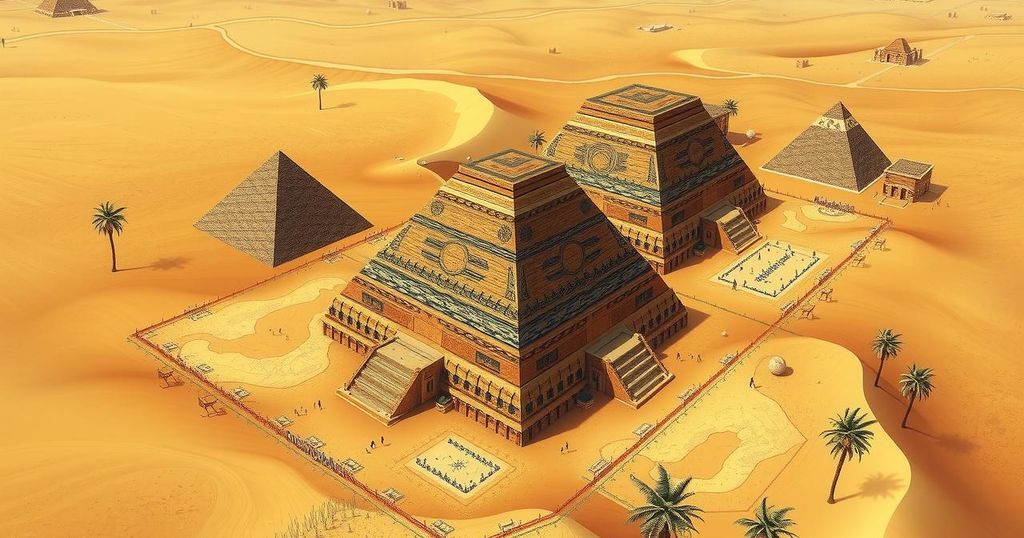Celebrity
AFRICA, ARCHAEOLOGY, BIONDI, EGYPT, ENTERTAINMENT, ENVIRONMENTAL IMPACT, EUROPE, FRANCE, GIZA, GIZA PLATEAU, HISTORY, MALANGA, MO, MOTOYUKI SATO, NUBIA, OF STRATHCLYDE, ROMAN EMPIRE, SCIENCE, SCIENCE WORLD NEWS, TO, TOHOKU UNIVERSITY, UNIVERSITY OF PISA, WORLD NEWS
Oliver Grayson
0 Comments
Revolutionary Discoveries Beneath the Giza Pyramids Challenge Historical Narratives
Recent archaeological discoveries beneath the Giza Pyramids unveil ancient structures and skeletal remains that challenge conventional beliefs about these monuments. Utilizing advanced radar technology, researchers have uncovered potential chambers and elaborate formations, suggesting the pyramids may have served multiple purposes. These revelations, along with diverse skeletal findings, prompt a reevaluation of the historical narrative surrounding the construction and function of the pyramids.
The Giza Pyramids, renowned symbols of ancient Egypt, may conceal secrets that could dramatically alter our understanding of history. Recent archaeological discoveries, employing advanced technologies, have begun to unveil underground structures and unexpected skeletal finds that suggest the pyramids may serve other purposes beyond mere tombs, potentially revolutionizing our perception of the past.
A notable development involves the discovery of immense vertical cylindrical formations situated 648 meters below the Giza Plateau. A research team led by Corrado Malanga from the University of Pisa and Filippo Biondi from the University of Strathclyde utilized Synthetic Aperture Radar (SAR) technology to explore this hidden domain. Their findings, first published in a 2022 study on arXiv, revealed chambers inside the Great Pyramid. A March 15 press release elaborated on their discoveries beneath the Khafre Pyramid, including five like-structures, each with intricate designs and connected to eight deep, spiraling wells.
Further analysis between 2021 and 2023 revealed utilizing ground-penetrating radar to identify an L-shaped structure and a deeper anomaly potentially indicative of a chamber beneath the pyramids. Notably, Motoyuki Sato from Tohoku University asserted, “The L-shape cannot be created in natural geological structures.” Additionally, the 2023 Scan Pyramids initiative uncovered a 30-foot corridor, heightening the mystery surrounding this ancient site.
In conjunction with structural discoveries, recent excavations have also unveiled human skeletons traced back to Nubia, dating to 3000 BCE, which predates the pyramids. Osteologist Dr. Sarah Field remarked, “It is surprising because it challenges the idea that pyramid builders were a uniform local workforce.” This contradicts traditional Egyptology, which posited that the pyramids were exclusively tombs for pharaohs.
Conventionally, the construction of these monumental structures is ascribed around 2500 BCE and incorporates remarkable mathematical concepts such as Pi, the golden ratio, and principles likened to the speed of light. Speculative theories have emerged, including ideas from historical figures like Nikola Tesla, who believed the pyramids could harness Earth’s energy. Christopher Dunn proposed the Great Pyramid functioned as a power plant, while Joseph Farrell even theorized its potential as a weapon, manipulating ancient physics.
As these cylindrical wells possibly channel energy or sound, with the cube-shaped structures acting as energy generators, the implications of these findings suggest a narrative more reflective of a science fiction epic than a strict historical account. Greg Reese, reporting via Substack, indicated that excavation efforts might be pursued, although obtaining necessary permits poses a challenge. Moreover, with a formerly active Nile branch facilitating stone transport becoming less viable, the narrative surrounding the pyramids beckons a reconsideration of both history and ancient technological capabilities.
In conclusion, the recent archaeological discoveries beneath the Giza Pyramids are uncovering a complex underground network and diverse skeletal evidence that challenge the traditional narratives of pyramid construction and purpose. These findings underscore the potential for significant revisions to our understanding of ancient Egyptian civilization, suggesting a rich tapestry of historical and possibly technological intricacies awaiting exploration. The implications of these developments warrant further investigation as researchers seek to decode the mysteries that lie beneath one of the world’s most iconic landmarks.
Original Source: www.marca.com




Post Comment